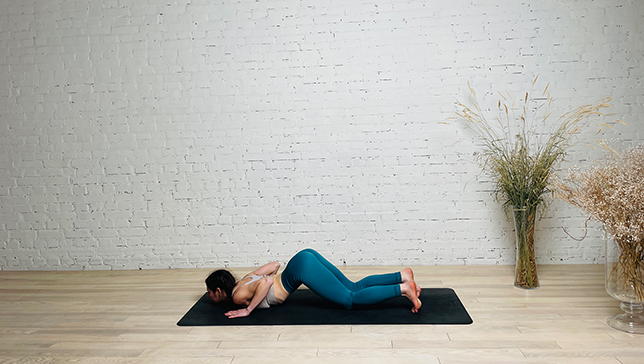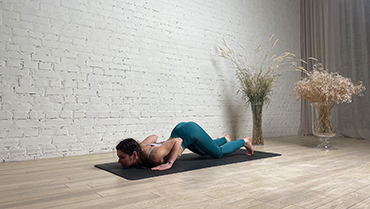Knees-Chest-Chin Pose - Ashtanga Namaskara

Contents
Knees-Chest-Chin Pose or Ashtanga Namaskara in Sanskrit (‘Asht’ means ‘eight’, ‘anga’ means ‘Limbs’ and ‘Namaskara’ means ‘Bowing down’) is often taught as a beginner’s alternative to Chaturanga Dandasana in a sun salutation sequence. You are prone with your back arched and chin, chest, hands, knees, and feet touching the mat. It’s a great way for beginners to work on building the arm strength needed for Chaturanga Dandasana. It also acts as a warm-up for the backbends you’ll likely get to later in your practice session. In the sun salutations, it is the sixth pose.
Also Known As: Eight-Limbed Salutation, Salute With Eight Parts, Caterpillar Pose
Pose Detail
- Difficulty: Beginners
- By Type: Chest Opening Yoga Poses, Flexibility Yoga Poses, Hip Opening Yoga Poses, Strengthening Yoga Poses
- Body Position: Prone Yoga Poses
- By Benefit: Yoga Poses For Neck Pain
Step-by-Step Instructions
Benefits and Contraindications
Prepares the body for low plank pose (chaturanga dandasana)
Releases tension in the upper back and shoulders
Builds arm and core strength
Builds spinal flexibility
Pregnancy
Neck, shoulder, elbow, or wrist injury
Carpal tunnel syndrome
Photo poses in different angles

Modifications and Props
- Lethargy or weakened abdominal muscles make it harder to hold the posture for long. So, the practitioner can place a block in between the thigh. By squeezing the block one can acquire the necessary strength to hold the position. However, it also assists the core muscles to engage as per their ability.
- Individuals with sensitive knees find it hard to remain in a contact with the floor too long. So, one can place a soft blanket to reduce the inflammation during the posture.
- Practitioners having discomfort in placing chest and chin to the ground can use a piece of soft cloth in order to insulate the situation. This will shift the focus on improving the balance of the posture.
Tips
Avoid these errors so you get the most from this pose.
-
Entering Pose Too Fast
Take this pose slowly and don’t let your body fall into it. Your back muscles will be engaged while lowering your body. You shouldn’t have pain or discomfort. If you feel any, take your chest down only as far as you can without pain. - Elbows Flared
Don’t let your elbows stick out. Concentrate on keeping them hugged to your sides and pointed towards your heels.
Frequently Asked Questions
Variations
- Wide Legged Four Limbed Staff Pose
- One Legged Four Limbed Staff Pose